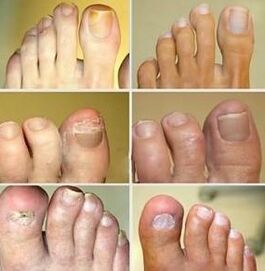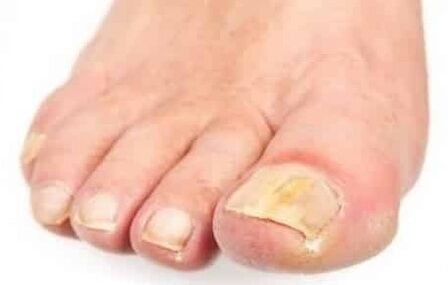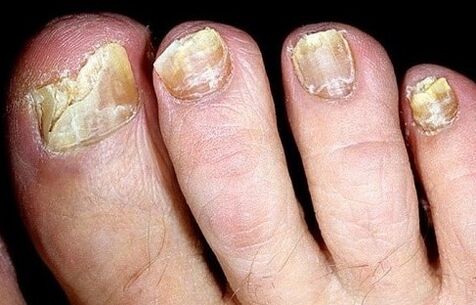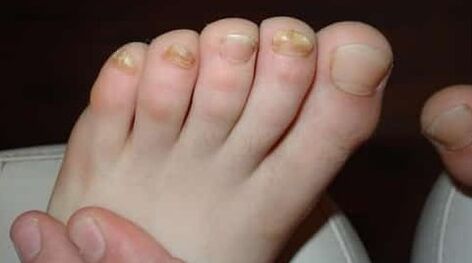Onychomycosis is a pathology that destroys the nail plate.Fungus eating keratin - the base of the nail construction.The infection falls into the space between the cells and begins its division.In advanced stages, pathology can affect the skin, intercal zone, heel.

Causes of nail fungus
Infected with onychomycosis is relatively simple.These infections can hide on the beach, in the public soul, swimming pool.The high probability of catching fungus from relatives or infected contacts (using a joint life).
There are several major prerequisites that can trigger the entry of the virus into the human body:
- Weak immune system - decreased protection of infectious diseases or inflammation;
- Vascular pathology (vein blockage) violation of internal organs (diabetes), leading to problems with blood circulation in the lower part;
- Small damage to the skin of the feet (lecet, microcracks, corn, corn) arising from wearing tight shoes;
- ignoring diaper rash and intensive sweat from lower feet;
- Violation of Steps -Heartbeat -Trying other people's shoes, visiting public places without slippers, and neglect of foot hygiene.
Type of nail fungus
Onychomycosis can trigger several types of fungi.For example, dermatophytes appear in the form of nails.There is a yellow spots forming along the edges or in the middle of the plate.In addition, longitudinal strips along the affected area can be observed.
Yeast fungus causes a nail plate deformation.He was very sophisticated and began to move from his place, to gray.The metabolism in the injured cells worsened, the commotion appeared on the nail roller.In addition, inflammation, edema, redness appear in the adjacent epidermis, loss of nail skin is observed.
Mold bacteria can injure the nail plate if there is a disease that causes nail nutrition.In this case, there is also plate approval, color change (from yellow light and green to brown and even black).
To find out the causes and pathogens of negative changes in the skin and nails, you must contact a specialist.Determination of free diseases and treatment without consulting a doctor who can be met with consequences.
Stage of disease

Nail mycosis affects healthy cells gradually.The disease has several stages of development, each of which has a manifestation in particular.
The first stage of onychomycosis (normotorophytic) has no bright manifestation.In most cases, it continues to be hidden.The first signs -the nails are slightly faded, the color changes, the microcracks and the yellow spots form in the form of a circle or oval, and the tuberosity appears.New fungus can be accompanied by itching and burning.It is difficult to recognize the infection at an early stage, as symptoms are similar to other diseases (psoriasis, liver pathology).
If the treatment does not start in time, the disease will go to the next stage - hypertrophic.The nails become thick, dark.There is a plate deformation, glory and its destruction.
The sophisticated form of nail disease is characterized by strong nail depletion, leading to further rejection.The adjacent skin becomes blue, unpleasant odor appears.
Symptom
Onychomycosis most often affects the nails on the feet, the hands are suffering less.The disease begins with the thumb and small fingers (the external edge touched), smoothly affecting all plates.
The main symptoms of onychomycosis will help determine fungal infections:
- the appearance of stripes and spots -white or green spots under the nails;
- plate cloud, color change (from yellow to dark brown);
- redness and peeling the skin around the nails;
- the appearance of roughness in the feet and between the fingers;
- Mold formation on nails.
Type of nail fungus disease
Onychomycosis is usually classified by the appearance of the affected area.Because the classification characteristics are fungus on the nails, it distinguishes in three species, depending on the clinical manifestation:
- Atropic, or onholytic - where the nail plate is significantly affected, to the level of rejection from the nail bed;
- The appearance of hypertropic, where it has lost its natural gloss, changes color (white or, on the other hand, dark) and structure (more real) with the appearance of various types of deformation and even destroys along the edges;
- Normotrophic - a type characterized by the lowest degree of damage, in which the nail plate does not thick, the remaining and smooth, but still changed outdoors due to the appearance of spots, strips and other visible changes in natural transparency and color.

In foreign countries, there is another classification that according to the fungus on the nails is divided into species depending on the place of the wound:
- Volume, where the entire nail plate is protected by the pathogenic process;
- distal - a form of damage, localizing only on the free edge of the nails above the tip of the finger;
- proximal, where the edge of the plate appears from the bottom of the nail roller is destroyed (opposite the nail -free edge!);
- Form of side damage, affecting the side of the nail plate.
Like what pathology
Fungal nail disease in the population has external similarities with other dermatological diseases of the negribik.Depending on the pathological level, the nails begin to look unwell as they lose shine and natural transparency.Instead of smooth and even, they become thick and defective, and are covered in a variety of colors (often white or dirty yellow).The soft tissues surrounding the layer of keratin destroyed by parasites are also involved in inflammation, swelling and ulcers.
If we consider a picture of the destruction of the nail plate in the dynamic perspective of the disease, then it can be divided into three consecutive stages:
- In the first stage, there are no signs, except for the ignorance of light, eyes or strips on a plate.
- At a clear level, quickly replacing the early ones, all symptoms of onychomycosis become obvious.
- The advanced level is the deterioration of the nail, can be supplemented by the unpleasant odor of the rotting tissues.
Reason for nail deformation
Molds, fungi such as yeast and dermatophytic fungi cause nail infectious diseases (onychomycosis), which are characterized by the same symptoms.All types of nail fungus on the feet or arms deform nail plate, change transparency, shine, color.Nail changes are found not only with onychomycosis, but also for injury, chronic paronichia (nail roller inflammation), psoriasis, hands exhaust, dermatitis.Before conclusions about fungal infections, you need to consider all possible options.
Symptoms of fungus
There are various nail fungus classifications, depending on the type and manifestation, they can have completely different signs and symptoms, so it is very important to determine it (psoriasis, eczema, lichen and dermatophyte).The shallow onychomycosis of the finger -the jar shows itself almost after the infection, consider the symptoms and signs of fungus on the toenails and arms:
- Thick plate;
- Fragile nails, fragile or torn not only near the edges, but also across the surface;
- The form of distorted, scaly structure;
- The early stages are the loss of excellence and elasticity;
- If the nails become black (not at the expense of cases when a person regularly works with the composition of the coloring or mechanical part);
- Nails of accidents under the skin;
- Dysbacteriosis begins, possibly a general decline in immunity, strength, drowsiness;
- Itching between the fingers and the feet is very much mentioned in children;
- Examination of the nail bed is a very common phenomenon and almost the last stage before losing a complete nail, called onycholysis.You can feel pain in your finger and find a slightly unpleasant odor;
- Skin is dry, cracked, rash appears, maybe even blood or soin appearance;
- The white or yellow circle of the mold under the nail, depending on the variety of fungi, can be bright, tedious, with the underlined edges and muddy structures.

Before starting an active action, it is necessary to minimize the negative effects of the external environment, to eliminateThe reason why fungus appearsUnder the nails on the feet:
- A warm and damp environment is ideal for the growth of various microorganisms, trying to dry shoes all the time after walking, wearing socks only from natural materials that provide heat and regular air exchange;
- Foot fungus often arises due to poor immunity, you can only step on the floor with your empty feet, and take infections, take vitamins to prevent it;
- Regular nail extensions can be one of the causes of onychomycosis, limiting procedures up to 1 session in six months;
- The most complicated is sympathetic - this is a fungus caused by an active dispute.They penetrate the holes between the nails and the fingers, can be at the sleep level for some time, and then grow significantly.Often, they are infected in public use (pool, shower, solarium), during other people's shoes operation, etc.
Normal types of mycosis stopped
There are many ways to get infections with foot fungus, but only possible with direct contact with pathogens.Often, this occurs during the use of other people's shoes or violates the rules of personal hygiene.Skin fungus on the feet usually manifests itself through the destruction of dermis, which is reflected in the form of peeling.The epidermis wounds in this case are due to the fact that the infection penetrates the layer of the skin, destroying its structure.
Modern medicine identifies the following options for fungal damage to the feet, respectively in different symptoms and treatment options:
- Intodallic mycosis is the most common form of the form of the disease.Symptoms are usually localized between 3 and 4 fingers, less frequently between 4 and 5, which looks like a crack covered with white film.It is possible to secrete a number of fluids, peel the boundaries, and the appearance of the diaper rash.Signs of fungus between feet can be accompanied by weak itching.Such fungus on the toes can initially occur completely without symptoms, but in the future there will be significant changes in the skin structure.
- Squamous hyperkeratotic fungus can be distinguished from other species by peeling and severe keratinization that affects the epidermis.It is a characteristic of people suffering from various types of dermatitis, especially atopic.This is another type of disease that can be clearly seen what the fungus is on the feet.The main symptoms of the disease are the emergence of erythema, painful pink nodules, in affected areas with clear boundaries.It is accompanied by weak itching, cracks in the legs, dryness, pain, yellowish and damage to the nail plate.Onychomycosis, usually accompanying this type of fungus, leads to nail stratification;
- Vesicular fungus is one of the most rare types of infection, affecting the skin.The disease receives its name for the formation of vesiculas - bubbles with fluid content, where erosion is later formed, which is dangerous for infection.The main signs that fungal vesiculosis is different: the appearance of blisters with a diameter of up to 1 centimeter, as well as weak itching;
- Deleted the fungus.In the early stages, there was slight peeling in the feet, as well as the appearance of small fractures, externally only affecting the upper layer of the epidermis.
- Fungus is a dyshidrotic, an infection found in medical practice in only 8% of patients with mycosis.It is localized mainly on and the footbox, manifests itself in the form of bubbles, gradually combining into one, after which the gap is followed by the formation of wide erosion.The danger of this type of fungus is the possibility of connecting bacterial infections, as pathogenic microorganisms easily penetrate the resulting wound;
- Intermical mycosis occurs not only independently, but also as a squamous shape of the foot fungus.It manifests itself between the fingers of the foot, characterized by the itching and severe burning, diaper rash and the appearance of erosion;
- Onychomycosis is another common choice of damage, which is a nail fungus on the feet.It usually develops from the free edge of the nail plate, the initial stage is characterized by the appearance of the yellow spots, and after which the disease occurs with the relaxation and complete leave of the nail.Often accompany other forms of fungal lesions;
- Candidal fungus, also known as yeast erosion, is located in the interdigital space.In this case, the fungus in the feet looks like a concentration of swollen skin areas, which can be surrounded by small shape pustules.

















